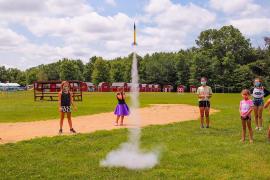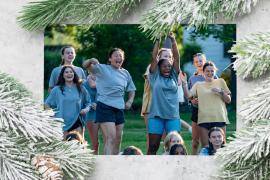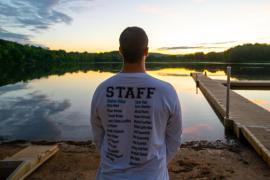Are you worried about staffing shortages and how many international staff you can hire? Have you heard potential staff say, “Thanks for the offer, but I need an internship”? Creating a field experience manual to attract and hire interns for camp jobs is a great answer for both concerns.
The manual serves a number of purposes, including showing your commitment to helping students learn valuable skills for their next job. University programs and professors will be happy to see a coherent set of written materials. This will give them more confidence partnering with your camp in the hiring process.
Here are some easy steps to get you started putting together your own field experience manual.
Step 1: Answer These Questions
- What types of camp jobs could be advertised as internships?
- E.g. ropes specialist for a Parks, Recreation, and Tourism or Outdoor Leadership internship.
- Can you provide practicums, field-based experiences, resident, or remote internships?
- What are the basic requirements for some of these experiences? Talk with some professors, internship coordinators, alumni, or staff and investigate what your camp can offer based on their insights on internship requirements.
- Is this a paid or unpaid internship? What kinds of benefits can you highlight at your camp?
- What is unique about your camp setting, program, mission that you want to make interns aware of?
- How do you translate the camp counselor experience into an academic internship?
- Who will supervise the interns and fill out required paperwork and respond to professor or internship coordinator inquiries? (Do not underestimate this requirement!)
- Who in your organization will commit to creating a manual and doing the grassroots work of getting connected with universities and colleges in the advertising campaign?
Step 2: Create Your Table of Contents
The table of contents will be your road map. Potential interns and professors will be guided through understanding what your camp is all about; what jobs they can apply for; logistics (dates, salary, benefits); what learning outcomes they can expect; how to build their resume with a camp job.
Here is a list of possible Table of Content headers:
- Who we are
- Where we are
- What we do
- Internship positions
- Job descriptions
- Weeks/hours requirements
- On-site supervisors for the interns
- Majors/degree programs recommended for internship positions
- Skills required
- Value-added elements
- Build your resume (*list of skills acquired)
Step 3: Write and Create
The nontraditional setting of camp as an internship requires that you take extra care to help universities understand how camp can translate to an academic internship. You need to sell them on this idea!
Camp is one of the great “human services” industries. It is important to recognize the hard skills, often practiced during program time and through specialist positions. You will also want to highlight the soft skills gained at camp that can carry over to any field of study. For example, an engineering major may think they need to work at a firm every summer; however, we know a robotics specialist position at camp will yield better communication, conflict resolution, public speaking, planning, and organization skills. These are fantastic skills that can be transferred to a productive engineering career!
The ACA Template for Camp-Initiated Field Experience Manual is great resource to help you get started. The template gives you a list of value-added elements to a field manual, resume building skills, and an important “what to include” section. Another great way to start is to review other industries’ intern manuals for both content creation and general design ideas.
Who else hires seasonal, large amounts of young adults who are doers? Examples may include Disney, hotels, resorts, churches, theme parks, etc. Perusing related websites can get the creative juices flowing. Canva.com is a free tool for layout and design. Be sure to include pictures of your camp, make the manual easy to read, and have an attractive design.
Here are some manual samples to get you thinking.
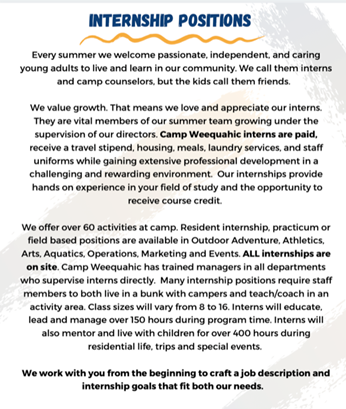
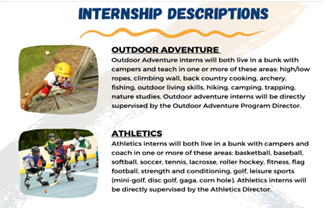
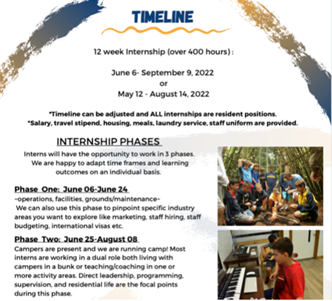
Step 4: Advertising
You have put in a lot of hours creating your manual. How do you get the information into the hands of future applicants?
- Create a grassroots list of internship coordinators or department heads and email out a brief note and a pdf of your manual.
- Create internship-specific job advertisements and post on internship websites and college career websites.
- Choose 10 universities with the major that you think will pair best with your internship offerings and pick up the phone and call the internship coordinator or department head.
This will take just as much effort as creating the manual itself, and it can certainly be worth the effort!
Step 5: Hiring and Supervision
On-site internship supervisors are a must and should be involved in the hiring process. Assistant directors and program directors who either work in a full-time capacity or are a part of the summer leadership team would be a good place to start when establishing this role. Whoever you choose must be organized, detail-oriented, and have enough time to get the work done.
On-site supervisors will act as the bridge between the intern and their direct supervisor to assure learning goals are shared and outcomes achieved. (e.g., the aquatics director will oversee an intern hired to lifeguard, and teach canoeing who is a parks, recreation, and tourism major; the outdoor adventure director will oversee an intern hired for nature studies who is a forestry major; the kitchen manager will oversee an intern hired as a “special meals” cook who is a culinary student.)
The on-site supervisor will also be responsible for all paperwork submission and communication with university or college internship coordinators. The paperwork is well worth the value of interns at camp!
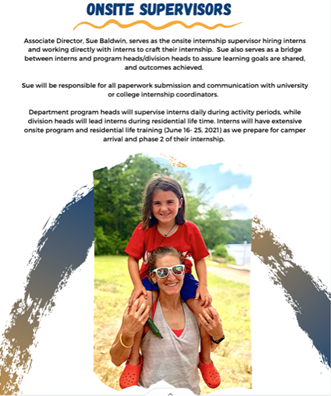
In the end, the whole point of this process is to give your camp the best chance of creating a new and sustainable recruitment channel for future staff members. While it will take some effort in getting it all in place and running, the benefits well exceed the time invested. A thriving internship program will help everyone “win” — the staff members, their colleges, camp, and, most importantly, the campers!
This blog was written on behalf of Project Real Job’s efforts to help camps recruit, hire, and retain staff.
Photo courtesy of Camp Courage in Owasso, OK
Sue Baldwin’s home away from home has been Camp Weequahic for over a decade. Prior to Camp Weequahic, Sue worked for Camp Group LLC. Sue spends her summers crafting each camper’s dream program, maneuvering our staff to all the fun places they need to be, and training and coaching our program leadership team to create amazing daily. Sue spends her off-season working to hire over 200 staff and create an incredible summer program. For more information, reach out to [email protected].
A big thanks to Dana and James Stassen, 10+ year veterans and experts in the field of hiring camp staff and general camp awesomeness for their help to write this blog!
The views and opinions expressed by contributors are their own and do not necessarily reflect the views of the American Camp Association or ACA employees.

